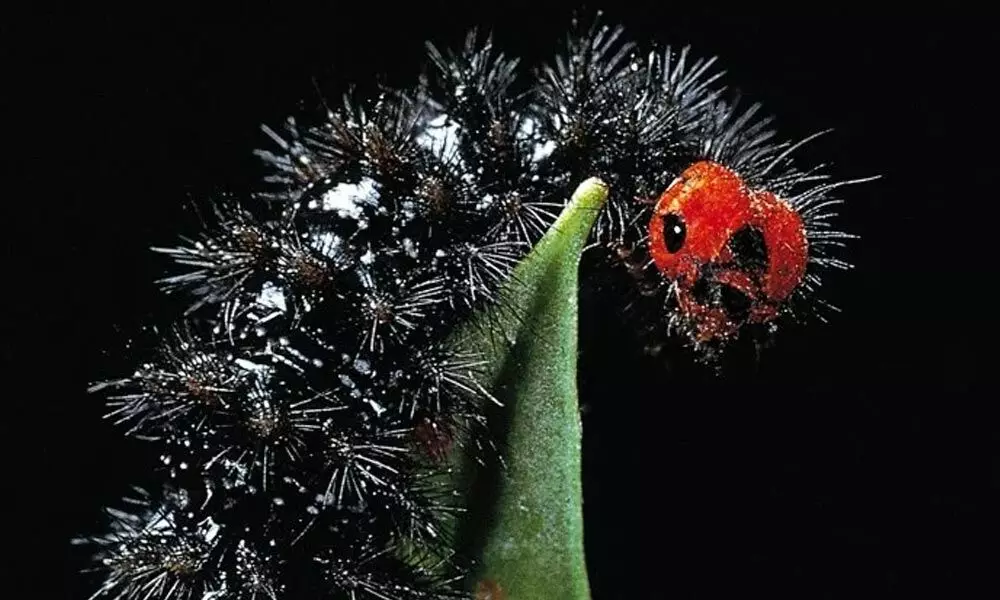Live
- Komatireddy brothers should get Oscar for lying: BRS
- KTR asks farmers to up the ante against TG govt
- SCB residents raise pitch for fair compensation for acquired lands
- TGMC crackdown on quackery continues, over 400 FIRs filed
- TG seeks PMAY fund boost as 80pc of State turns urban
- Don’t buy assets from known ganja smugglers: DIG
- Youth Cong takes out ‘mashaal rally’ condemning Amit Shah’s statement on Ambedkar
- Hyderabad remained peaceful in 2024,but sees sharp spike in cybercrimes
- MP, West MLA distribute cheques to critical patients
- Hyderabad Book Fair a big draw among book lovers
Just In
Scientist's Screwup And Released Stomach-Bursting Parasites

Hans News Service | 28 Sept 2021 4:30 PM IST

x
The Glanville fritillary butterfly in caterpillar form. (Paul Starosta/Getty Images)
Highlights
- An ecologist's miscalculation resulted in the release of a 'Russian doll' set of stomach-bursting parasites onto a secluded Finnish island.
- He intended to see how a colony of one species might survive in a hard habitat.
According to a new study, an ecologist's miscalculation resulted in the release of a 'Russian doll' set of stomach-bursting parasites onto a secluded Finnish island.
When biologist Ilkka Hanski transplanted Glanville fritillary butterflies (Melitaea cinxia) to the island of Sottunga in the land archipelago thirty years ago, he intended to see how a colony of one species might survive in a hard habitat.
He had no clue, though, that he'd be accompanied by a trio of nested parasites, with two parasites residing within another parasite, which was itself nested inside some of the butterflies.
The latter parasites, Hyposoter horticola parasitic wasp larvae, consume the Glanville caterpillars from the inside out, erupting from their host's abdomen to form a cocoon around the caterpillar's carcass for pupation.
H. horticola kills the caterpillar host before being killed by M. stigmaticus if all three stowaways are aboard. The hyperparasite burrows out 10 days later, eating the bacteria-infested flesh of the first wasp parasite and subsequently the caterpillar's carcass.
Despite several, substantial population crashes among their butterfly hosts, all four species are still alive on the tiny, 10.4-square-mile (27-square-kilometer) island 30 years after their introduction.
Researchers analysed the genetics of the H. horticola population and its bacterium in a new study published on July 7 in the journal Molecular Biology to figure out how these parasites accomplished this incredible feat.
The butterflies' tenuous hold on the island, as well as countless instances of their near-extinction from the ecosystem, is "a classic loss of biodiversity scenario," according to Anne Duplouy, the study's primary author.
As caterpillars, Glanville butterflies eat entirely on two meadow plants, making the species vulnerable to environmental changes, according to Duplouy, an evolutionary scientist at Lund University in Sweden.
"Bushes and trees take over, and the host plants die extinct under tree coverings," she warned, if these meadows are allowed to become overrun.
Climate change, such as drought, has a big impact on Glanville caterpillars because it can wake them up too early from diapause, which is a stage of suspended animation that some animal embryos enter to survive harsh conditions.
The butterflies have survived despite multiple near-extinction occurrences, and with astonishingly high genetic variety – owing to the enormous genetic diversity of the individuals that were first introduced to the island.
The parasites are thriving in the same way that their butterfly hosts are. They are still alive, according to Duplouy, for two reasons.
Both H. horticola and M. stigmaticus are better flyers than the butterflies, with H. horticola being able to surf in strong winds in particular. Individual H. horticola wasps have been transported to previously uninhabited islands north of Sottunga, according to the researchers' surveys. Second, wasps, especially H. horticola, have an extremely efficient reproductive strategy.
One parasitoid female will take a daily tour of the field, checking on the progress of the butterfly eggs. The parasitoid lays its eggs inside the still-intact butterfly eggshell when those are ready to hatch as larvae. As a result, as long as the butterfly is present, the wasp is likely to stay.
According to the researchers, hyperparasitoid M. stigmaticus wasps, which aren't as good flyers as their H. horticola wasp hosts, are less well dispersed across the islands surrounding Sottunga and have resorted to inbreeding to survive.
The researchers believe the parasites' unintentional introduction is an interesting case study, but it also serves as a strong warning about the importance of understanding both endangered species and the species linked with them before attempting to restore any of them to a new environment.
Parasitoid wasps, for example, are routinely used in agriculture as pest control, so humans are familiar with them, but a more elusive species may have wreaked havoc on the new environment.
Despite the butterflies' and parasitoids' remarkable survival thus far, Duplouy believes that population crashes – induced by unexpected drought – are likely to worsen as the consequences of climate change grow more intense.
Since the population in the south of Sottunga, in Föglö, became extinct a few years ago, and Sottunga has been a very, very small population for many years, they are afraid that they will witness the end of it very soon. After 30 years of dedication, it would be a tragedy to lose it.

Next Story
More Stories
ADVERTISEMENT
© 2024 Hyderabad Media House Limited/The Hans India. All rights reserved. Powered by hocalwire.com






